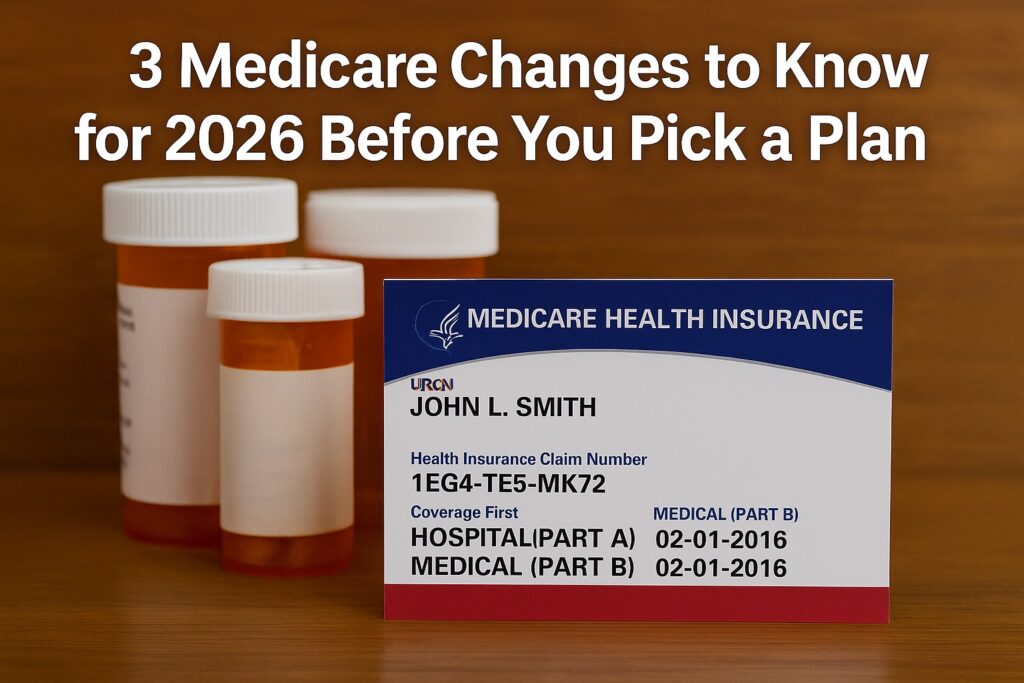Introduction: A New Chapter in Medicare Savings
Each fall, millions of older Americans review their Medicare options during Open Enrollment (Oct 15 – Dec 7). But this year’s decisions come with something new: real change for 2026.
From a long-awaited cap on out-of-pocket drug costs to expanded coverage for home and mental-health services, 2026 is shaping up to be one of the most significant Medicare updates in years.
Here’s what’s changing, how it affects your wallet, and the simple steps you can take now to get ready.
1️⃣ The $2,100 Out-of-Pocket Cap on Prescription Drugs
For the first time ever, Medicare Part D plans will include a hard annual limit on what beneficiaries pay out of pocket for covered prescriptions.
What It Means
- Starting January 1, 2026, you will never pay more than $2,100 per year for covered prescription drugs.
- Once your total spending (including deductible, copays, and coinsurance) hits that cap, your costs drop to $0 for the rest of the year.
- The old “donut hole” coverage gap will disappear completely.
Why It Matters
This reform, part of the Inflation Reduction Act, targets one of seniors’ biggest pain points—skyrocketing pharmacy bills.
Today, about 1.5 million Medicare enrollees spend more than $2,100 annually on medications. In 2026, those individuals could save hundreds or even thousands of dollars.
Practical Tip
When comparing Part D plans this fall, look at:
- The estimated annual drug cost (not just the monthly premium).
- Whether your pharmacy is preferred in the network.
- Which of your prescriptions fall into Tier 1–2 (generic) versus Tier 3+ (brand) categories.
If your total costs are projected near the $2,000 range, this new cap could fully eliminate your late-year pharmacy expenses.
2️⃣ Lower Insulin Prices Continue — and More Drugs May Follow
In 2023, Medicare began capping insulin copays at $35 per month. That protection remains—and is expanding.
What’s Staying
- The $35 cap applies to every covered insulin product under Part D or Medicare Advantage.
- It applies even before you meet your deductible.
- Plans must clearly show insulin options and costs in their 2026 materials.
What’s New
Several high-cost drugs for chronic conditions (like blood thinners and certain cancer medications) are next in line for negotiated pricing. The first wave of negotiated drugs begins in 2026, with prices taking effect in 2027.
While those savings won’t fully kick in this year, it signals a turning point: Medicare can now negotiate directly with drug manufacturers, something Congress had banned for nearly two decades.
Why It Matters
- Diabetes patients on multiple insulins could save $400 – $600 per year.
- Negotiated pricing could save Medicare $100 billion over a decade — and potentially slow premium growth for everyone.
Pro Tip
Check your plan’s Preferred Drug List (PDL) to confirm your insulin brand and pharmacy are covered.
If you use mail-order or a 90-day refill, you should still pay no more than $35 × months supplied.
3️⃣ More Mental-Health & Home-Based Care Options
Healthcare isn’t just about pills and hospitals — and Medicare is finally catching up.
In 2026, several new benefits will roll out across both Original Medicare and Medicare Advantage.
What’s Expanding
- Tele-mental health: Continued coverage for virtual therapy sessions, even after the COVID-era waivers expire.
- Peer support specialists: New codes let certified counselors provide affordable mental-health assistance.
- Home-based care coordination: Broader coverage for in-home health assessments, caregiver training, and fall-prevention visits.
- Respite services: Some Medicare Advantage plans can now pay for short-term in-home care to give family caregivers a break.
Why It Matters
A growing number of older adults live alone or manage chronic stress and grief. These updates mark a major step toward whole-person care—addressing emotional health, independence, and safety at home.
If you or a loved one has been delaying therapy or home-care support due to cost, 2026 may bring affordable options that didn’t exist before.
Understanding What Hasn’t Changed
- Open Enrollment Dates: Still Oct 15 – Dec 7.
- Basic Medicare Parts A & B: Hospital and medical coverage remain unchanged.
- Free Preventive Services: Flu shots, annual wellness visits, mammograms, and screenings remain $0.
- Extra Help (Low-Income Subsidy): Continues to assist lower-income seniors with premiums and copays.
How to Prepare Before Enrollment Closes
1. Review Your Annual Notice of Change (ANOC)
Your plan mailed this in September. It lists premium increases, formulary changes, and new benefits.
2. Make a Medication List
Write down each drug name, dosage, and frequency.
You’ll need this for accurate cost comparisons on Medicare.gov/plan-compare.
3. Use the Official Medicare Plan Finder
Avoid private “look-alike” sites. The official Plan Finder lets you filter by:
- ZIP code
- preferred pharmacies
- drug list
- plan rating (1–5 stars)
4. Ask for Free Help
Certified SHIP counselors (State Health Insurance Assistance Program) offer one-on-one, unbiased help in every state.
Find yours at shiphelp.org.
Real-World Example
Mary, a 72-year-old from Cherry Hill, NJ, spends about $3,400 a year on heart medication.
Under the 2026 cap, her total out-of-pocket drops to $2,100, saving her $1,300.
Her insulin remains capped at $35 per month, and her Medicare Advantage plan’s new tele-therapy coverage gives her access to weekly counseling sessions at no extra cost.
These small policy changes translate into big peace of mind for seniors like Mary.
How to Avoid Common Pitfalls
🚫 Ignoring drug-tier changes. Even familiar medications can move to higher copay tiers each year.
🚫 Relying solely on premiums. A low monthly premium can hide high copays — check total yearly cost.
🚫 Falling for marketing hype. Some ads exaggerate “free benefits.” Always confirm details at Medicare.gov or 1-800-MEDICARE.
🚫 Forgetting about travel coverage. If you spend winters out of state, verify your plan’s network before enrolling.
Estimated 2026 Medicare Costs (Projected Averages)
| Category | 2025 | 2026 Estimate | Note |
| Part B Premium | $174.70 | $179–$182 | Small inflation adjustment |
| Part B Deductible | $240 | ≈ $250 | Tied to medical inflation |
| Part D Base Premium | $55 | ≈ $57 | Varies by plan |
| Out-of-Pocket Drug Cap | No limit | $2,100 | New in 2026 |
Looking Ahead: What’s Next After 2026
- More Drug Price Negotiations (2027–2029): Additional medications will enter Medicare’s negotiation list.
- Simplified Plan Materials: Expect shorter, easier-to-read enrollment booklets.
- Potential Dental & Vision Expansion: Lawmakers continue exploring optional add-ons under Medicare Advantage.
These trends all move toward one goal: making Medicare more affordable and understandable for older adults.
Key Takeaways
- 🩺 New $2,100 cap on annual drug costs starts Jan 2026.
- 💉 $35 insulin cap continues, saving millions of seniors money.
- 🧠 Mental-health and home-care coverage expands under both Original Medicare and Advantage plans.
- 📆 Open Enrollment remains Oct 15 – Dec 7 — compare your plan now.
- ✅ Always use Medicare.gov or SHIP counselors for trustworthy guidance.





